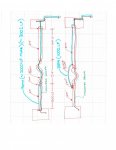I've looked through the 2017 NEC, SOARES Book on Grounding & Bonding, and Mike Holt's printed book, Illustrated Guide to Understanding NEC requirements for Grounding Vs. Bonding, but I'm unable to locate my exact scenario.
Setup: Branch Circuit Conductor from Panel via 20LF EMT conduit transitioning to short section (~2LF) LFNMC, and then transitioning back to (~2LF) EMT before terminating in Metallic Enclosure. The Branch circuit conductor has an EGC run in the conduit through the entire section terminating in the metallic enclosure.
The installation location is interior and not located in a hazardous location.
Is a bonding strap required across the LFNMC if I'm not using the EMT as an EGC to keep the system electrically continuous?
Setup: Branch Circuit Conductor from Panel via 20LF EMT conduit transitioning to short section (~2LF) LFNMC, and then transitioning back to (~2LF) EMT before terminating in Metallic Enclosure. The Branch circuit conductor has an EGC run in the conduit through the entire section terminating in the metallic enclosure.
The installation location is interior and not located in a hazardous location.
Is a bonding strap required across the LFNMC if I'm not using the EMT as an EGC to keep the system electrically continuous?


